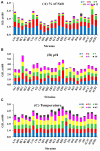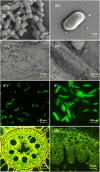Complete Genome Sequence of Enterobacter roggenkampii ED5, a Nitrogen Fixing Plant Growth Promoting Endophytic Bacterium With Biocontrol and Stress Tolerance Properties, Isolated From Sugarcane Root
- PMID: 33072048
- PMCID: PMC7536287
- DOI: 10.3389/fmicb.2020.580081
Complete Genome Sequence of Enterobacter roggenkampii ED5, a Nitrogen Fixing Plant Growth Promoting Endophytic Bacterium With Biocontrol and Stress Tolerance Properties, Isolated From Sugarcane Root
Abstract
Sugarcane is the leading economic crop in China, requires huge quantities of nitrogen in the preliminary plant growth stages. However, the use of an enormous amount of nitrogen fertilizer increases the production price, and have detrimental results on the environment, causes severe soil and water pollution. In this study, a total of 175 endophytic strains were obtained from the sugarcane roots, belonging to five different species, i.e., Saccharum officinarum, Saccharum barberi, Saccharum robustum, Saccharum spontaneum, and Saccharum sinense. Among these, only 23 Enterobacter strains were chosen based on nitrogen fixation, PGP traits, hydrolytic enzymes production, and antifungal activities. Also, all selected strains were showed diverse growth range under different stress conditions, i.e., pH (5-10), temperature (20-45°C), and NaCl (7-12%) and 14 strains confirmed positive nifH, and 12 strains for acdS gene amplification, suggested that these strains could fix nitrogen along with stress tolerance properties. Out of 23 selected strains, Enterobacter roggenkampii ED5 was the most potent strain. Hence, this strain was further selected for comprehensive genome analysis, which includes a genome size of 4,702,851 bp and 56.05% of the average G + C content. Genome annotations estimated 4349 protein-coding with 83 tRNA and 25 rRNA genes. The CDSs number allocated to the KEGG, COG, and GO database were 2839, 4028, and 2949. We recognized a total set of genes that are possibly concerned with ACC deaminase activity, siderophores and plant hormones production, nitrogen and phosphate metabolism, symbiosis, root colonization, biofilm formation, sulfur assimilation and metabolism, along with resistance response toward a range of biotic and abiotic stresses. E. roggenkampii ED5 strain was also a proficient colonizer in sugarcane (variety GT11) and enhanced growth of sugarcane under the greenhouse. To the best of our knowledge, this is the first information on the whole-genome sequence study of endophytic E. roggenkampii ED5 bacterium associated with sugarcane root. And, our findings proposed that identification of predicted genes and metabolic pathways might describe this strain an eco-friendly bioresource to promote sugarcane growth by several mechanisms of actions under multi-stresses.
Keywords: E. roggenkampii; PGPB; endophyte; nitrogen fixation; root colonization; stress; sugarcane; whole-genome sequencing.
Copyright © 2020 Guo, Singh, Singh, Li, Sharma, Xing, Song, Yang and Li.
Figures








Similar articles
-
Differential Protein Expression Analysis of Two Sugarcane Varieties in Response to Diazotrophic Plant Growth-Promoting Endophyte Enterobacter roggenkampii ED5.Front Plant Sci. 2021 Nov 23;12:727741. doi: 10.3389/fpls.2021.727741. eCollection 2021. Front Plant Sci. 2021. PMID: 34887881 Free PMC article.
-
Effect of endophytic diazotroph Enterobacter roggenkampii ED5 on nitrogen-metabolism-related microecology in the sugarcane rhizosphere at different nitrogen levels.Front Microbiol. 2023 Aug 15;14:1132016. doi: 10.3389/fmicb.2023.1132016. eCollection 2023. Front Microbiol. 2023. PMID: 37649627 Free PMC article.
-
Complete genome analysis of sugarcane root associated endophytic diazotroph Pseudomonas aeruginosa DJ06 revealing versatile molecular mechanism involved in sugarcane development.Front Microbiol. 2023 Apr 20;14:1096754. doi: 10.3389/fmicb.2023.1096754. eCollection 2023. Front Microbiol. 2023. PMID: 37152763 Free PMC article.
-
Endophytic Actinobacteria and the Interaction of Micromonospora and Nitrogen Fixing Plants.Front Microbiol. 2015 Dec 1;6:1341. doi: 10.3389/fmicb.2015.01341. eCollection 2015. Front Microbiol. 2015. PMID: 26648923 Free PMC article. Review.
-
Bacillus subtilis: A plant-growth promoting rhizobacterium that also impacts biotic stress.Saudi J Biol Sci. 2019 Sep;26(6):1291-1297. doi: 10.1016/j.sjbs.2019.05.004. Epub 2019 May 20. Saudi J Biol Sci. 2019. PMID: 31516360 Free PMC article. Review.
Cited by
-
Gut microbiome of century-old snail specimens stable across time in preservation.Microbiome. 2022 Jun 29;10(1):99. doi: 10.1186/s40168-022-01286-z. Microbiome. 2022. PMID: 35765039 Free PMC article.
-
Functional Investigation of Plant Growth Promoting Rhizobacterial Communities in Sugarcane.Front Microbiol. 2022 Jan 4;12:783925. doi: 10.3389/fmicb.2021.783925. eCollection 2021. Front Microbiol. 2022. PMID: 35058904 Free PMC article.
-
Biosynthetic Mechanisms of Secondary Metabolites Promoted by the Interaction Between Endophytes and Plant Hosts.Front Microbiol. 2022 Jul 11;13:928967. doi: 10.3389/fmicb.2022.928967. eCollection 2022. Front Microbiol. 2022. PMID: 35898919 Free PMC article. Review.
-
Screening and identification of an aflatoxin B1-degrading strain from the Qinghai-Tibet Plateau and biodegradation products analysis.Front Microbiol. 2024 May 1;15:1367297. doi: 10.3389/fmicb.2024.1367297. eCollection 2024. Front Microbiol. 2024. PMID: 38751722 Free PMC article.
-
Schizotrophic Sclerotinia sclerotiorum-Mediated Root and Rhizosphere Microbiome Alterations Activate Growth and Disease Resistance in Wheat.Microbiol Spectr. 2023 Jun 15;11(3):e0098123. doi: 10.1128/spectrum.00981-23. Epub 2023 May 22. Microbiol Spectr. 2023. PMID: 37212718 Free PMC article.
References
-
- Arora N. K., Tewari S., Singh R. (2013). ”Multifaceted plant-associated microbes and their mechanisms diminish the concept of direct and indirect PGPRs,” in Plant Microbe Symbiosis; Fundamentals and Advances, ed. Arora N. K. (Lucknow: Springer; ), 411–449. 10.1007/978-81-322-1287-4_16 - DOI
LinkOut - more resources
Full Text Sources
Miscellaneous

